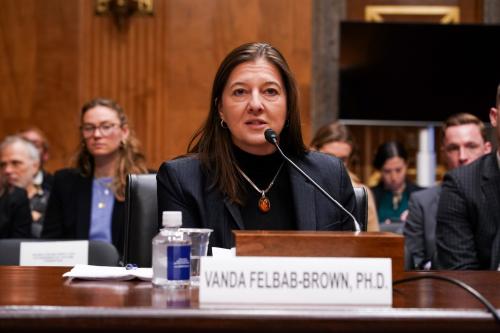The Cartagena Summit of the Americas where heads of state will meet in middle April comes at a time of acute crime crisis in Latin America and growing opposition to U.S. counternarcotics policies. President Otto Perez Molina of Guatemala has called for legalizing the drug trade, following calls for drug policy reform of several former Latin American presidents. El Salvador has been reeling from allegations of a deal between criminal gangs and the government. Mexico has been overwhelmed by drug violence.
Organized crime exploits the “soft spots” along trafficking routes. Squeezed in one area, traffickers seek out regions with underdeveloped rule of law institutions, weak fiscal capacity, extensive corruption, and marginalized populations susceptible to participation in illicit economies. Today’s prime examples are Central America and West Africa.
In response, local governments and external partners, such as the United States, often adopt the wrong policies by defining the problem in absolute terms — dismantling organized crime or stopping illegal drug flows. Such goals are mostly unattainable and guarantee costly failures. More attainable, but crucial objectives such as reducing the harms associated with the drug trade and other crime – the violence, corruption, and erosion of the social fabric – are largely ignored.
Reducing the violence around drug trafficking is particularly critical. Societies experiencing chronic and uncontrolled violence tend to have little faith in government and can transfer their loyalties to criminal groups that provide a modicum of safety, albeit perverse safety. Governments that effectively reduce violence often do not rid the country of organized crime but lessen its grip on society, thereby giving citizens greater confidence in government, encouraging citizen cooperation with law enforcement, and aiding the transformation of a national security threat into a public safety problem.
Yet those Central American countries – Honduras, El Salvador, and Guatemala – that have been hardest hit by the shift in trafficking routes have pursued the most counterproductive policies. Iron-fisted (mano dura) approaches that criminalize membership in youth gangs, on the assumption that this would discourage gang membership and crime, have backfired. The extensive imprisonment of even low-level criminals, some rounded up for their tattoos or idling on the streets, flooded ill-equipped corrections systems. Prisons became breeding grounds for hardened criminals. The sheer volume of crime has overwhelmed police forces — often under-resourced, corrupt, and intermeshed with organized crime — and resulted in their becoming apathetic and favorably-disposed to vigilante militias.
Nor is the solution merely to stand up specialized interdiction units (SIUs), a favorite U.S. recipe. In the context of weak state capacity and high corruption, SIUs are prime targets for corruption and can turn into powerful and technologically-savvy drug traffickers. The violent Zetas in Mexico and the Kaibiles in Guatemala originated as elite special forces before becoming criminals. If SIUs are stood up, not only must they be carefully vetted at the beginning, but external donors must also devise roll-back mechanisms if such units go rogue.
Moreover, SIUs mostly concentrate on crime kingpins. But such high-value targeting often intensifies violence, by stimulating internal succession fights and turf wars. Mexico is a prime example of where high-value-targeting increased violence, creating a more chaotic situation out-of-government control. Where violence has declined in Mexico, such as in Tijuana and Ciudad Juarez, it has been because one DTO came to dominate the criminal market in the area.
A more effective law enforcement strategy would focus on four elements:
- Developing violence-reduction policing and crime-prevention strategies. Such a strategy might entail prioritizing the most violent group or focusing efforts in a particular geographic location. Different criteria for focusing law-enforcement efforts come with different costs, benefits, and tradeoffs; but the goal is to get away from an unfocused round-‘em-up-lock-‘em-up approach that overwhelms criminal justice systems.
- Building up the capacity of police and prosecutors to target the middle layer of criminal organizations – the lawyers, accountants, and lieutenants in waiting – that are the guts of their operations. By weakening this middle layer in a decisive blow, law enforcement undermines the group’s operational capacity and ability to regenerate leadership. If a turf war follows, it tends to be less violent because the DTO has a limited capacity to resist a takeover.
- Prioritizing common crime such as theft, street brawls, kidnapping, and extortion by
developing effective local police forces and prosecutions. An effective response to street crime produces several key benefits: It satisfies a key demand of the public and strengthens the bonds and cooperation between the community and the state. It also removes white noise from the overall crime picture and allows law enforcement to develop better intelligence on organized crime. - Building up the entire law-enforcement pyramid from local respondents to street crime to
specialized serious-crime units and prosecutors, instead of merely parachuting SIUs on top of a crumbled and corrupt law-enforcement apparatus.
Ultimately, external assistance to combat organized crime can only be effective if there is a genuine commitment by recipient governments and sufficient buy-in from local communities. U.S. anti-crime policy abroad needs to take both far more seriously, even while steering other countries away from ineffective policies.



Commentary
A Better Strategy to Combat Organized Crime in Mexico and Central America
April 13, 2012